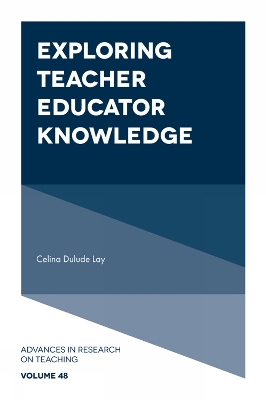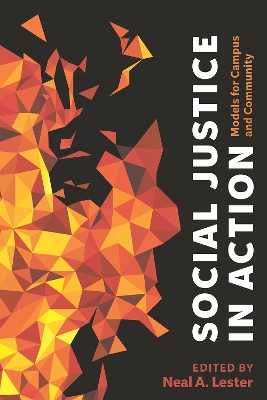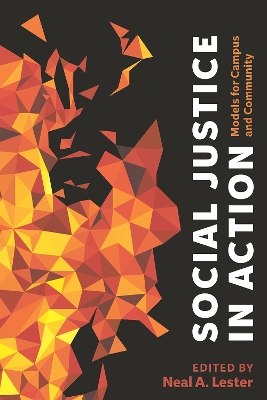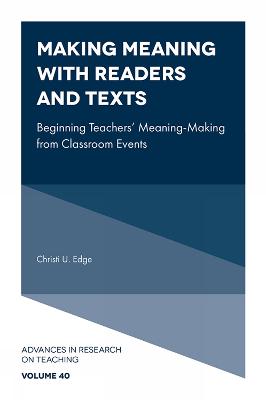Global Meaning Making
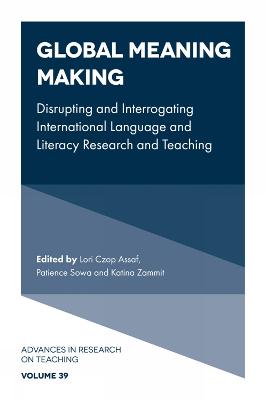 portes grátis
portes grátis
Global Meaning Making
Disrupting and Interrogating International Language and Literacy Research and Teaching
Sowa, Patience; Zammit, Katina; Assaf, Lori Czop
Emerald Publishing Limited
08/2022
336
Dura
Inglês
9781801179331
15 a 20 dias
585
Descrição não disponível.
Preface; Robert Tierney
Section 1. Literacy Programs, Policies and Curriculum
Chapter 1. Introduction: Stitching a Global Meaning Making Patchwork Quilt; Patience Sowa, Katina Zammit, and Lori Czop Assaf
Chapter 2. International Literacy Development in the Peruvian Amazon: Three Problematic Assumptions; Desiree Pallais-Downing
Chapter 3. Becoming Global Meaning Makers: The Making and Remaking of Literacy Education Expertise and Practice in Belize; Odelia Caliz, Ray Lawrence, Rashid Murillo, Denise Neal, Jennifer Sanders, Yvonne Tyndall-Howell, and Deborah Williams
Chapter 4. Tapasa: An Invitation to Decolonize Literacy Teacher Education in Aotearoa New Zealand; Jessica Cira Rubin and David Taufui Mikato Fa'avae
Chapter 5. Academic literacies from the South to the South: Tensions and Advances in Three Initiatives Located in Ibero-America; Maria Constanza Errazuriz, Lucia Natale, and Juan Antonio Nunez Cortes
Section 2. Language of Instruction Policies and Practices
Chapter 6. Challenges and Practical Considerations of the Choice of Languages of Instruction in Low and Middle Income Countries; Patience Sowa
Chapter 7. Challenging Existing Spaces: Deconstructing Indigenous Power Imbalances within Aotearoa New Zealand; Rachel Martin and Amanda Denston
Chapter 8. Between Many Worlds: Which Language to use in Primary Schools - Mother Tongue, Vernacular, or English?; Carol Abiri and Katina Zammit
Chapter 9. Community Mapping in One Rural Community in South Africa: Teacher Candidates Grapple with Colonizing Influences on Language and Literacy; Lori Czop Assaf, Kristie O'Donnell Lussier, and Meagan Hoff
Section 3. Engaging in Global Literacies
Chapter 10. Interrupting Existing Frames and Being Mindful: An Examination of Culturally Responsive Teachers of High Performing Immigrant and Refugee Youth in a German Secondary School; K. Dara Hill
Chapter 11. Cosmopolitanism to Frame Teaching Global Literacies; Shea N. Kerkhoff and Ming Yi
Chapter 12. "My Way is a Little Bit Wrong:" How Refugee-Background Students Negotiate the Boundaries of American Academic Literacies; Meagan Hoff
Chapter 13. School Interrupted: Issues and Perspectives from COVID-19 Remote Teaching; Chinwe H. Ikpeze and Susan Schultz
Chapter 14. Voices of Chinese Students: What Motivates them to Read?; Jiening Ruan and Susan Schultz
Chapter 15. Conclusion; Katina Zammit, Lori Czop Assaf, and Patience Sowa
Section 1. Literacy Programs, Policies and Curriculum
Chapter 1. Introduction: Stitching a Global Meaning Making Patchwork Quilt; Patience Sowa, Katina Zammit, and Lori Czop Assaf
Chapter 2. International Literacy Development in the Peruvian Amazon: Three Problematic Assumptions; Desiree Pallais-Downing
Chapter 3. Becoming Global Meaning Makers: The Making and Remaking of Literacy Education Expertise and Practice in Belize; Odelia Caliz, Ray Lawrence, Rashid Murillo, Denise Neal, Jennifer Sanders, Yvonne Tyndall-Howell, and Deborah Williams
Chapter 4. Tapasa: An Invitation to Decolonize Literacy Teacher Education in Aotearoa New Zealand; Jessica Cira Rubin and David Taufui Mikato Fa'avae
Chapter 5. Academic literacies from the South to the South: Tensions and Advances in Three Initiatives Located in Ibero-America; Maria Constanza Errazuriz, Lucia Natale, and Juan Antonio Nunez Cortes
Section 2. Language of Instruction Policies and Practices
Chapter 6. Challenges and Practical Considerations of the Choice of Languages of Instruction in Low and Middle Income Countries; Patience Sowa
Chapter 7. Challenging Existing Spaces: Deconstructing Indigenous Power Imbalances within Aotearoa New Zealand; Rachel Martin and Amanda Denston
Chapter 8. Between Many Worlds: Which Language to use in Primary Schools - Mother Tongue, Vernacular, or English?; Carol Abiri and Katina Zammit
Chapter 9. Community Mapping in One Rural Community in South Africa: Teacher Candidates Grapple with Colonizing Influences on Language and Literacy; Lori Czop Assaf, Kristie O'Donnell Lussier, and Meagan Hoff
Section 3. Engaging in Global Literacies
Chapter 10. Interrupting Existing Frames and Being Mindful: An Examination of Culturally Responsive Teachers of High Performing Immigrant and Refugee Youth in a German Secondary School; K. Dara Hill
Chapter 11. Cosmopolitanism to Frame Teaching Global Literacies; Shea N. Kerkhoff and Ming Yi
Chapter 12. "My Way is a Little Bit Wrong:" How Refugee-Background Students Negotiate the Boundaries of American Academic Literacies; Meagan Hoff
Chapter 13. School Interrupted: Issues and Perspectives from COVID-19 Remote Teaching; Chinwe H. Ikpeze and Susan Schultz
Chapter 14. Voices of Chinese Students: What Motivates them to Read?; Jiening Ruan and Susan Schultz
Chapter 15. Conclusion; Katina Zammit, Lori Czop Assaf, and Patience Sowa
Este título pertence ao(s) assunto(s) indicados(s). Para ver outros títulos clique no assunto desejado.
Comparative Education; Multilingual Populations; Translanguaging; Indigenous Languages; Mindfulness; Community Mapping
Preface; Robert Tierney
Section 1. Literacy Programs, Policies and Curriculum
Chapter 1. Introduction: Stitching a Global Meaning Making Patchwork Quilt; Patience Sowa, Katina Zammit, and Lori Czop Assaf
Chapter 2. International Literacy Development in the Peruvian Amazon: Three Problematic Assumptions; Desiree Pallais-Downing
Chapter 3. Becoming Global Meaning Makers: The Making and Remaking of Literacy Education Expertise and Practice in Belize; Odelia Caliz, Ray Lawrence, Rashid Murillo, Denise Neal, Jennifer Sanders, Yvonne Tyndall-Howell, and Deborah Williams
Chapter 4. Tapasa: An Invitation to Decolonize Literacy Teacher Education in Aotearoa New Zealand; Jessica Cira Rubin and David Taufui Mikato Fa'avae
Chapter 5. Academic literacies from the South to the South: Tensions and Advances in Three Initiatives Located in Ibero-America; Maria Constanza Errazuriz, Lucia Natale, and Juan Antonio Nunez Cortes
Section 2. Language of Instruction Policies and Practices
Chapter 6. Challenges and Practical Considerations of the Choice of Languages of Instruction in Low and Middle Income Countries; Patience Sowa
Chapter 7. Challenging Existing Spaces: Deconstructing Indigenous Power Imbalances within Aotearoa New Zealand; Rachel Martin and Amanda Denston
Chapter 8. Between Many Worlds: Which Language to use in Primary Schools - Mother Tongue, Vernacular, or English?; Carol Abiri and Katina Zammit
Chapter 9. Community Mapping in One Rural Community in South Africa: Teacher Candidates Grapple with Colonizing Influences on Language and Literacy; Lori Czop Assaf, Kristie O'Donnell Lussier, and Meagan Hoff
Section 3. Engaging in Global Literacies
Chapter 10. Interrupting Existing Frames and Being Mindful: An Examination of Culturally Responsive Teachers of High Performing Immigrant and Refugee Youth in a German Secondary School; K. Dara Hill
Chapter 11. Cosmopolitanism to Frame Teaching Global Literacies; Shea N. Kerkhoff and Ming Yi
Chapter 12. "My Way is a Little Bit Wrong:" How Refugee-Background Students Negotiate the Boundaries of American Academic Literacies; Meagan Hoff
Chapter 13. School Interrupted: Issues and Perspectives from COVID-19 Remote Teaching; Chinwe H. Ikpeze and Susan Schultz
Chapter 14. Voices of Chinese Students: What Motivates them to Read?; Jiening Ruan and Susan Schultz
Chapter 15. Conclusion; Katina Zammit, Lori Czop Assaf, and Patience Sowa
Section 1. Literacy Programs, Policies and Curriculum
Chapter 1. Introduction: Stitching a Global Meaning Making Patchwork Quilt; Patience Sowa, Katina Zammit, and Lori Czop Assaf
Chapter 2. International Literacy Development in the Peruvian Amazon: Three Problematic Assumptions; Desiree Pallais-Downing
Chapter 3. Becoming Global Meaning Makers: The Making and Remaking of Literacy Education Expertise and Practice in Belize; Odelia Caliz, Ray Lawrence, Rashid Murillo, Denise Neal, Jennifer Sanders, Yvonne Tyndall-Howell, and Deborah Williams
Chapter 4. Tapasa: An Invitation to Decolonize Literacy Teacher Education in Aotearoa New Zealand; Jessica Cira Rubin and David Taufui Mikato Fa'avae
Chapter 5. Academic literacies from the South to the South: Tensions and Advances in Three Initiatives Located in Ibero-America; Maria Constanza Errazuriz, Lucia Natale, and Juan Antonio Nunez Cortes
Section 2. Language of Instruction Policies and Practices
Chapter 6. Challenges and Practical Considerations of the Choice of Languages of Instruction in Low and Middle Income Countries; Patience Sowa
Chapter 7. Challenging Existing Spaces: Deconstructing Indigenous Power Imbalances within Aotearoa New Zealand; Rachel Martin and Amanda Denston
Chapter 8. Between Many Worlds: Which Language to use in Primary Schools - Mother Tongue, Vernacular, or English?; Carol Abiri and Katina Zammit
Chapter 9. Community Mapping in One Rural Community in South Africa: Teacher Candidates Grapple with Colonizing Influences on Language and Literacy; Lori Czop Assaf, Kristie O'Donnell Lussier, and Meagan Hoff
Section 3. Engaging in Global Literacies
Chapter 10. Interrupting Existing Frames and Being Mindful: An Examination of Culturally Responsive Teachers of High Performing Immigrant and Refugee Youth in a German Secondary School; K. Dara Hill
Chapter 11. Cosmopolitanism to Frame Teaching Global Literacies; Shea N. Kerkhoff and Ming Yi
Chapter 12. "My Way is a Little Bit Wrong:" How Refugee-Background Students Negotiate the Boundaries of American Academic Literacies; Meagan Hoff
Chapter 13. School Interrupted: Issues and Perspectives from COVID-19 Remote Teaching; Chinwe H. Ikpeze and Susan Schultz
Chapter 14. Voices of Chinese Students: What Motivates them to Read?; Jiening Ruan and Susan Schultz
Chapter 15. Conclusion; Katina Zammit, Lori Czop Assaf, and Patience Sowa
Este título pertence ao(s) assunto(s) indicados(s). Para ver outros títulos clique no assunto desejado.

